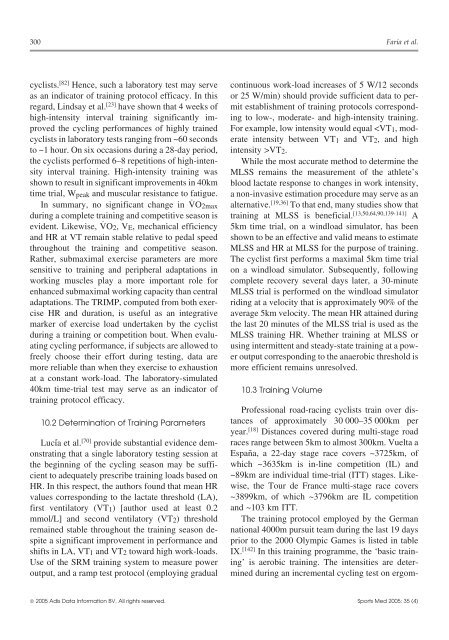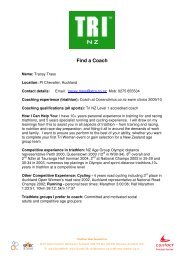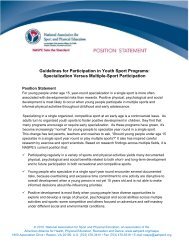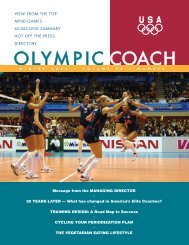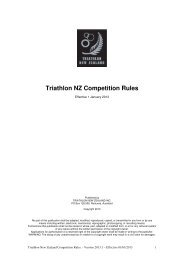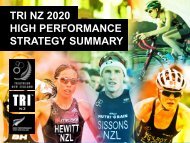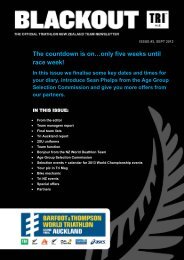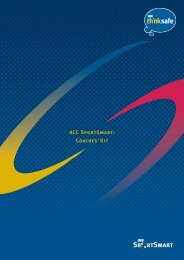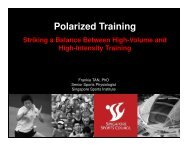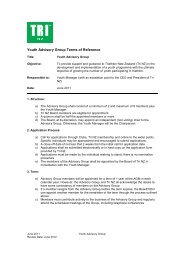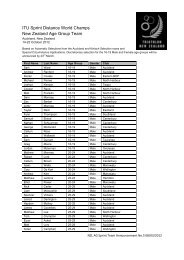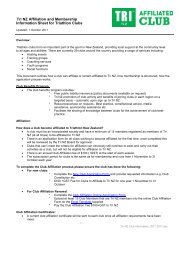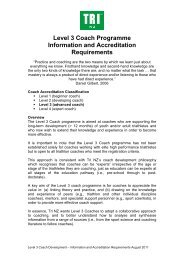The Science of Cycling - IngentaConnect
The Science of Cycling - IngentaConnect
The Science of Cycling - IngentaConnect
Create successful ePaper yourself
Turn your PDF publications into a flip-book with our unique Google optimized e-Paper software.
300 Faria et al.<br />
cyclists. [82] Hence, such a laboratory test may serve<br />
as an indicator <strong>of</strong> training protocol efficacy. In this<br />
regard, Lindsay et al. [23] have shown that 4 weeks <strong>of</strong><br />
high-intensity interval training significantly improved<br />
the cycling performances <strong>of</strong> highly trained<br />
cyclists in laboratory tests ranging from ~60 seconds<br />
to ~1 hour. On six occasions during a 28-day period,<br />
the cyclists performed 6–8 repetitions <strong>of</strong> high-intensity<br />
interval training. High-intensity training was<br />
shown to result in significant improvements in 40km<br />
time trial, Wpeak and muscular resistance to fatigue.<br />
In summary, no significant change in ˙VO2max<br />
during a complete training and competitive season is<br />
evident. Likewise, ˙VO2, VE, mechanical efficiency<br />
and HR at VT remain stable relative to pedal speed<br />
throughout the training and competitive season.<br />
Rather, submaximal exercise parameters are more<br />
sensitive to training and peripheral adaptations in<br />
working muscles play a more important role for<br />
enhanced submaximal working capacity than central<br />
adaptations. <strong>The</strong> TRIMP, computed from both exercise<br />
HR and duration, is useful as an integrative<br />
marker <strong>of</strong> exercise load undertaken by the cyclist<br />
during a training or competition bout. When evaluating<br />
cycling performance, if subjects are allowed to<br />
freely choose their effort during testing, data are<br />
more reliable than when they exercise to exhaustion<br />
at a constant work-load. <strong>The</strong> laboratory-simulated<br />
40km time-trial test may serve as an indicator <strong>of</strong><br />
training protocol efficacy.<br />
10.2 Determination <strong>of</strong> Training Parameters<br />
Lucía et al. [70] provide substantial evidence demonstrating<br />
that a single laboratory testing session at<br />
the beginning <strong>of</strong> the cycling season may be sufficient<br />
to adequately prescribe training loads based on<br />
HR. In this respect, the authors found that mean HR<br />
values corresponding to the lactate threshold (LA),<br />
first ventilatory (VT1) [author used at least 0.2<br />
mmol/L] and second ventilatory (VT2) threshold<br />
remained stable throughout the training season despite<br />
a significant improvement in performance and<br />
shifts in LA, VT1 and VT2 toward high work-loads.<br />
Use <strong>of</strong> the SRM training system to measure power<br />
output, and a ramp test protocol (employing gradual<br />
continuous work-load increases <strong>of</strong> 5 W/12 seconds<br />
or 25 W/min) should provide sufficient data to per-<br />
mit establishment <strong>of</strong> training protocols correspond-<br />
ing to low-, moderate- and high-intensity training.<br />
For example, low intensity would equal VT2.<br />
While the most accurate method to determine the<br />
MLSS remains the measurement <strong>of</strong> the athlete’s<br />
blood lactate response to changes in work intensity,<br />
a non-invasive estimation procedure may serve as an<br />
alternative. [19,36] To that end, many studies show that<br />
training at MLSS is beneficial. [13,50,64,90,139-141] A<br />
5km time trial, on a windload simulator, has been<br />
shown to be an effective and valid means to estimate<br />
MLSS and HR at MLSS for the purpose <strong>of</strong> training.<br />
<strong>The</strong> cyclist first performs a maximal 5km time trial<br />
on a windload simulator. Subsequently, following<br />
complete recovery several days later, a 30-minute<br />
MLSS trial is performed on the windload simulator<br />
riding at a velocity that is approximately 90% <strong>of</strong> the<br />
average 5km velocity. <strong>The</strong> mean HR attained during<br />
the last 20 minutes <strong>of</strong> the MLSS trial is used as the<br />
MLSS training HR. Whether training at MLSS or<br />
using intermittent and steady-state training at a pow-<br />
er output corresponding to the anaerobic threshold is<br />
more efficient remains unresolved.<br />
10.3 Training Volume<br />
Pr<strong>of</strong>essional road-racing cyclists train over distances<br />
<strong>of</strong> approximately 30 000–35 000km per<br />
year. [18] Distances covered during multi-stage road<br />
races range between 5km to almost 300km. Vuelta a<br />
España, a 22-day stage race covers ~3725km, <strong>of</strong><br />
which ~3635km is in-line competition (IL) and<br />
~89km are individual time-trial (ITT) stages. Like-<br />
wise, the Tour de France multi-stage race covers<br />
~3899km, <strong>of</strong> which ~3796km are IL competition<br />
and ~103 km ITT.<br />
<strong>The</strong> training protocol employed by the German<br />
national 4000m pursuit team during the last 19 days<br />
prior to the 2000 Olympic Games is listed in table<br />
IX. [142] In this training programme, the ‘basic training’<br />
is aerobic training. <strong>The</strong> intensities are deter-<br />
mined during an incremental cycling test on ergom-<br />
© 2005 Adis Data Information BV. All rights reserved. Sports Med 2005; 35 (4)


